Salyut 1: the first space station
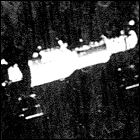 Salyut 1, the first orbiting space station in history is launched, unmanned, by the Soviet Union. With Salyut 1, the Soviet space program intends to vault ahead of the United States in a new space discipline (namely long stays in space and the study of human endurance in a zero-G environment), having lost the moon race. The first Salyut station will orbit Earth for less than a year.
Salyut 1, the first orbiting space station in history is launched, unmanned, by the Soviet Union. With Salyut 1, the Soviet space program intends to vault ahead of the United States in a new space discipline (namely long stays in space and the study of human endurance in a zero-G environment), having lost the moon race. The first Salyut station will orbit Earth for less than a year.

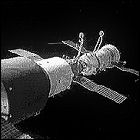 The Soviet Union launches the Soyuz 10 mission, intended to become the first crew to occupy an Earth-orbiting space station. Flying a new modification of the Soyuz vehicle, fitted with a new system for docking to the Salyut 1 space station, are Vladimir Shatalov, Alexei Yeliseyev and Nikolai Rukavishnikov, but they won’t be the first space station crew in history: the Soyuz capsule fails to hard-dock to the station, making it impossible for them to enter. Soyuz 10 returns to Earth after two days, and even on the return journey the cosmonauts are sickened by toxic fumes in their environmental system. Salyut 1 remains in orbit, still unmanned.
The Soviet Union launches the Soyuz 10 mission, intended to become the first crew to occupy an Earth-orbiting space station. Flying a new modification of the Soyuz vehicle, fitted with a new system for docking to the Salyut 1 space station, are Vladimir Shatalov, Alexei Yeliseyev and Nikolai Rukavishnikov, but they won’t be the first space station crew in history: the Soyuz capsule fails to hard-dock to the station, making it impossible for them to enter. Soyuz 10 returns to Earth after two days, and even on the return journey the cosmonauts are sickened by toxic fumes in their environmental system. Salyut 1 remains in orbit, still unmanned.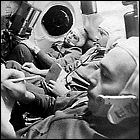 After a tuberculosis scare forces Soviet space officials to ground the mission’s original crew, the backup crew of Soyuz 11 lifts off to become the first occupants of a manned space station. Experiencing none of the difficulties that plagued the earlier Soyuz 10 attempt to dock with Salyut 1, the Soyuz 11 crew stays aboard Salyut for 22 days, a new record for a manned space mission.
After a tuberculosis scare forces Soviet space officials to ground the mission’s original crew, the backup crew of Soyuz 11 lifts off to become the first occupants of a manned space station. Experiencing none of the difficulties that plagued the earlier Soyuz 10 attempt to dock with Salyut 1, the Soyuz 11 crew stays aboard Salyut for 22 days, a new record for a manned space mission.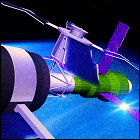 With planning already well underway for the Apollo-Soyuz mission which won’t take place until
With planning already well underway for the Apollo-Soyuz mission which won’t take place until 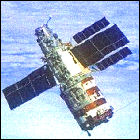 The Soviet Union launches a second space station, and the first station designed exclusively for military tasks in orbit. Salyut 2 is the first station to use the Almaz military space station design devised in the 1960s as a response to the US Air Force’s never-flown Manned Orbiting Laboratory. Within two weeks, however, technical difficulties take their toll: Salyut 2 begins to tumble out of control, and its crew compartment depressurizes. (The redesigned Soyuz vehicle is not ready to fly yet, so no crew ever visits Salyut 2.) The second Soviet space station burns up in the atmosphere less than two months after launch.
The Soviet Union launches a second space station, and the first station designed exclusively for military tasks in orbit. Salyut 2 is the first station to use the Almaz military space station design devised in the 1960s as a response to the US Air Force’s never-flown Manned Orbiting Laboratory. Within two weeks, however, technical difficulties take their toll: Salyut 2 begins to tumble out of control, and its crew compartment depressurizes. (The redesigned Soyuz vehicle is not ready to fly yet, so no crew ever visits Salyut 2.) The second Soviet space station burns up in the atmosphere less than two months after launch.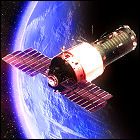 The Soviet Union launches its third space station, again based on the Almaz military space station architecture. Salyut 3 remains in orbit for over half a year, and is eventually visited by the crews of Soyuz 14 and Soyuz 15, though the latter mission fails to dock. Despite international agreements already in place to prevent the militarization of space, Salyut 3 is the first armed space station, packing a non-steerable anti-aircraft gun (for defending the station, though from what is never made clear). Fortunately, the space war never happens and Salyut 3 is never forced to defend itself.
The Soviet Union launches its third space station, again based on the Almaz military space station architecture. Salyut 3 remains in orbit for over half a year, and is eventually visited by the crews of Soyuz 14 and Soyuz 15, though the latter mission fails to dock. Despite international agreements already in place to prevent the militarization of space, Salyut 3 is the first armed space station, packing a non-steerable anti-aircraft gun (for defending the station, though from what is never made clear). Fortunately, the space war never happens and Salyut 3 is never forced to defend itself.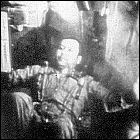 The Soviet Union launches the Soyuz 14 mission, sending cosmonauts Yuri Artyukhin and Pavel Popovich to embark on a two-week stay aboard the Salyut 3 military space station. Though some medical science experiments are performed at Salyut 3, the majority of the crew’s time is taken up with observations of the Earth’s surface, essentially making Salyut 3 the first manned military surveillance satellite. Before leaving, the crew of two offloads supplies so that the new Salyut 3 crew can stay for several months.
The Soviet Union launches the Soyuz 14 mission, sending cosmonauts Yuri Artyukhin and Pavel Popovich to embark on a two-week stay aboard the Salyut 3 military space station. Though some medical science experiments are performed at Salyut 3, the majority of the crew’s time is taken up with observations of the Earth’s surface, essentially making Salyut 3 the first manned military surveillance satellite. Before leaving, the crew of two offloads supplies so that the new Salyut 3 crew can stay for several months.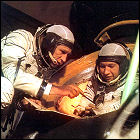 The Soviet space program continues with the launch of Soyuz 15, carrying cosmonauts Lev Dyomin and Gennadi Sarafanov. This is intended to be the second crew to occupy the Salyut 3 military space station, but spacecraft systems intended to automate the rendezvous and docking process fail. After manual dockings are attempted, the Soyuz vehicle is running low on fuel and the crew is recalled to Earth after only two days. (Trying to dodge questions about the nature of Salyut 3’s mission objectives, Soviet space authorities later claim that Soyuz 15 was never going to dock with the station.) No further crews are sent to board Salyut 3.
The Soviet space program continues with the launch of Soyuz 15, carrying cosmonauts Lev Dyomin and Gennadi Sarafanov. This is intended to be the second crew to occupy the Salyut 3 military space station, but spacecraft systems intended to automate the rendezvous and docking process fail. After manual dockings are attempted, the Soyuz vehicle is running low on fuel and the crew is recalled to Earth after only two days. (Trying to dodge questions about the nature of Salyut 3’s mission objectives, Soviet space authorities later claim that Soyuz 15 was never going to dock with the station.) No further crews are sent to board Salyut 3.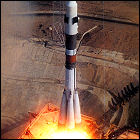 The Soviet Union launches cosmonauts Boris Volynov and Vitaly Zholobov aboard Soyuz 21, the first mission to the newly-orbited Salyut 5 military space station. Though a few scientific experiments are conducted, most of the crew’s activities involve military surveillance of Earth. The crew’s stay is intended to last as long as two months, though an emergency aboard the station will cut that stay short.
The Soviet Union launches cosmonauts Boris Volynov and Vitaly Zholobov aboard Soyuz 21, the first mission to the newly-orbited Salyut 5 military space station. Though a few scientific experiments are conducted, most of the crew’s activities involve military surveillance of Earth. The crew’s stay is intended to last as long as two months, though an emergency aboard the station will cut that stay short.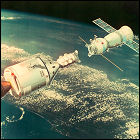 With the 1972 agreement having resulted in the successful Apollo-Soyuz Test Project, the United States and the Soviet Union formally renew the Space Cooperation Agreement. As an immediate goal to build on Apollo-Soyuz, both countries hold tentative discussions about docking the American Space Shuttle (which, it is still assumed, will be in space before the 1970s are out) and a Soviet Salyut space station. Though the shuttle’s first flight is still being delayed, the biggest hurdle will prove to be international relations, specifically a renewed chilling of the Cold War thanks to the Soviet Union’s 1979 invasion of Afghanistan.
With the 1972 agreement having resulted in the successful Apollo-Soyuz Test Project, the United States and the Soviet Union formally renew the Space Cooperation Agreement. As an immediate goal to build on Apollo-Soyuz, both countries hold tentative discussions about docking the American Space Shuttle (which, it is still assumed, will be in space before the 1970s are out) and a Soviet Salyut space station. Though the shuttle’s first flight is still being delayed, the biggest hurdle will prove to be international relations, specifically a renewed chilling of the Cold War thanks to the Soviet Union’s 1979 invasion of Afghanistan.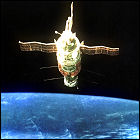 The Soviet Union launches the redesigned Salyut 6 space station, which will remain in service for five years. With six years of experience in building and operating space stations, Soviet space engineers embark on a rethink of station construction, opting for a more modular approach with Salyut 6: the new station has docking ports fore and aft, with additional station modules and automated resupply vehicles already on the drawing board. The dual docking ports also allow for multiple Soyuz capsules to be berthed at Salyut 6, making larger crews possible.
The Soviet Union launches the redesigned Salyut 6 space station, which will remain in service for five years. With six years of experience in building and operating space stations, Soviet space engineers embark on a rethink of station construction, opting for a more modular approach with Salyut 6: the new station has docking ports fore and aft, with additional station modules and automated resupply vehicles already on the drawing board. The dual docking ports also allow for multiple Soyuz capsules to be berthed at Salyut 6, making larger crews possible.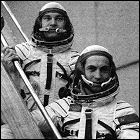 The Soviet Union launches Soyuz 25 into Earth orbit, with cosmonauts Vladimir Kovalyonok and Valery Ryumin set to become the first occupants of the new Salyut 6 space station. However, the crew is unable to successfully dock Soyuz 25 to Salyut 6, and after a fifth attempt to dock, the mission is aborted and the cosmonauts are recalled to Earth due to concerns about the remaining fuel in their vehicle. As a result, Soyuz 25 is the last all-rookie Soviet space crew until the 1990s.
The Soviet Union launches Soyuz 25 into Earth orbit, with cosmonauts Vladimir Kovalyonok and Valery Ryumin set to become the first occupants of the new Salyut 6 space station. However, the crew is unable to successfully dock Soyuz 25 to Salyut 6, and after a fifth attempt to dock, the mission is aborted and the cosmonauts are recalled to Earth due to concerns about the remaining fuel in their vehicle. As a result, Soyuz 25 is the last all-rookie Soviet space crew until the 1990s.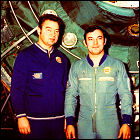 A two-man crew – cosmonauts Yuri Romanenko and Georgi Grechko – is launched aboard Soyuz 26 by the Soviet Union. The Soyuz capsule docks with the recently-launched Salyut 6 space station, and the crew takes up residence for over three months, setting a new space endurance record at 96 days. The Soyuz 27 crew visits in January and swaps vehicles with the station occupants, meaning that Romanenko and Grechko technically return to Earth aboard Soyuz 27 in March 1978. Ten days into the mission, the first Soviet spacewalk since 1969 is undertaken to examine the forward docking hatch of Salyut 6, with which the previous mission failed to connect. This spacewalk was the first outing of the Soviet-made Orlan spacesuit, a design still in use on the International Space Station in the 21st century.
A two-man crew – cosmonauts Yuri Romanenko and Georgi Grechko – is launched aboard Soyuz 26 by the Soviet Union. The Soyuz capsule docks with the recently-launched Salyut 6 space station, and the crew takes up residence for over three months, setting a new space endurance record at 96 days. The Soyuz 27 crew visits in January and swaps vehicles with the station occupants, meaning that Romanenko and Grechko technically return to Earth aboard Soyuz 27 in March 1978. Ten days into the mission, the first Soviet spacewalk since 1969 is undertaken to examine the forward docking hatch of Salyut 6, with which the previous mission failed to connect. This spacewalk was the first outing of the Soviet-made Orlan spacesuit, a design still in use on the International Space Station in the 21st century.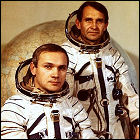 The Soviet Union launches Soyuz 27 on a mission to the Salyut 6 space station – the first instance of three vehicles being docked together in space. Cosmonauts Vladimir Dzhanibekov and Oleg Makarov spend six days with the crew of Soyuz 26 board the station, although Dzhanibekov and Makarov swap capsules with the station crew, leaving the newer vehicle at the station for their eventual return. The crew of Soyuz 27 is in space for less than a week, but their spacecraft remains in orbit, connected to Salyut, for over two months.
The Soviet Union launches Soyuz 27 on a mission to the Salyut 6 space station – the first instance of three vehicles being docked together in space. Cosmonauts Vladimir Dzhanibekov and Oleg Makarov spend six days with the crew of Soyuz 26 board the station, although Dzhanibekov and Makarov swap capsules with the station crew, leaving the newer vehicle at the station for their eventual return. The crew of Soyuz 27 is in space for less than a week, but their spacecraft remains in orbit, connected to Salyut, for over two months.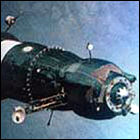 The first Soviet-made uncrewed Progress resupply vehicle lifts off en route to the manned Salyut 6 space station. Looking more or less like a Soyuz vehicle, Progress is an automated freighter whose systems lock onto Salyut’s docking transponder, guiding the unmanned craft toward a smooth and completely automated docking (though ground controllers stand by to take manual control by remote). Since Progress is not required to return a crew to Earth, its engines and their fuel can help to boost Salyut 6 into a higher orbit when necessary. It carries over 5,000 pounds of food, clothes and other supplies, and can automatically refill the station’s air and fuel supplies. Progress vehicles become an integral part of the space program, remaining in service long enough to resupply the International Space Station in the 21st century.
The first Soviet-made uncrewed Progress resupply vehicle lifts off en route to the manned Salyut 6 space station. Looking more or less like a Soyuz vehicle, Progress is an automated freighter whose systems lock onto Salyut’s docking transponder, guiding the unmanned craft toward a smooth and completely automated docking (though ground controllers stand by to take manual control by remote). Since Progress is not required to return a crew to Earth, its engines and their fuel can help to boost Salyut 6 into a higher orbit when necessary. It carries over 5,000 pounds of food, clothes and other supplies, and can automatically refill the station’s air and fuel supplies. Progress vehicles become an integral part of the space program, remaining in service long enough to resupply the International Space Station in the 21st century.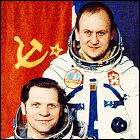 The Soviet Union launches the Soyuz 28 mission, the first manned flight in its Interkosmos series of international space missions. Cosmonaut Vladimír Remek is the first Czech in space, as well as the first space traveler not born in the Soviet Union or the United States; along with Soyuz 28 mission commander Alexei Gubarev, Remek visits the Salyut 6 space station for several days, though is presence is purely political showmanship; Remek later reveals that he had few actual functions to perform during the flight. Soyuz 28 spends a total of nearly eight days in space before returning to Earth.
The Soviet Union launches the Soyuz 28 mission, the first manned flight in its Interkosmos series of international space missions. Cosmonaut Vladimír Remek is the first Czech in space, as well as the first space traveler not born in the Soviet Union or the United States; along with Soyuz 28 mission commander Alexei Gubarev, Remek visits the Salyut 6 space station for several days, though is presence is purely political showmanship; Remek later reveals that he had few actual functions to perform during the flight. Soyuz 28 spends a total of nearly eight days in space before returning to Earth.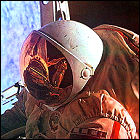 The Soviet Union launches Soyuz 29 on a mission to berth at space station Salyut 6 for a period of around four months. Cosmonauts Vladimir Kovalyonok and Aleksandr Ivanchenkov are aboard, and they eventually set a new space endurance record, remaining in orbit for 139 days. Numerous material science experiments are carried out, as well as a spacewalk to retrieve samples of various materials left exposed to space outside the station. The crew is also assigned to take on a more rigorous exercise program. They will return to Earth in November after swapping vehicles with the crew of Soyuz 31.
The Soviet Union launches Soyuz 29 on a mission to berth at space station Salyut 6 for a period of around four months. Cosmonauts Vladimir Kovalyonok and Aleksandr Ivanchenkov are aboard, and they eventually set a new space endurance record, remaining in orbit for 139 days. Numerous material science experiments are carried out, as well as a spacewalk to retrieve samples of various materials left exposed to space outside the station. The crew is also assigned to take on a more rigorous exercise program. They will return to Earth in November after swapping vehicles with the crew of Soyuz 31.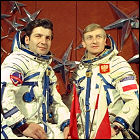 Soyuz 30 lifts off en route to a brief visit with the crew of space station Salyut 6. This is the second manned Interkosmos mission, with cosmonaut Pyotr Klimuk and the first Polish cosmonaut, Mirosław Hermaszewski, aboard. They dock at Salyut 6 after two days in orbit, and spend a total of eight days in space. Though some joint experiments are conducted among the four occupants of the station, the Soyuz 30 crew frequently has to perform experiments in its own Soyuz vehicle to avoid getting in the station crew’s way, and the mission is kept short to free up the second docking port for a Progress unmanned supply vehicle launched four days after Soyuz 30 returns to Earth.
Soyuz 30 lifts off en route to a brief visit with the crew of space station Salyut 6. This is the second manned Interkosmos mission, with cosmonaut Pyotr Klimuk and the first Polish cosmonaut, Mirosław Hermaszewski, aboard. They dock at Salyut 6 after two days in orbit, and spend a total of eight days in space. Though some joint experiments are conducted among the four occupants of the station, the Soyuz 30 crew frequently has to perform experiments in its own Soyuz vehicle to avoid getting in the station crew’s way, and the mission is kept short to free up the second docking port for a Progress unmanned supply vehicle launched four days after Soyuz 30 returns to Earth.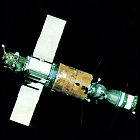 The Soviet Union’s Soyuz 31 mission to the Salyut 6 space station lifts off, with cosmonauts Valery Bykovsky and Sigmund Jahn (the first East German space traveler) aboard. The crews are segregated less than on previous Interkosmos flights, and the Soyuz 31 crew is in space for over a week. They leave their vehicle at Salyut 6 and return in the Soyuz 29 vehicle on September 3rd.
The Soviet Union’s Soyuz 31 mission to the Salyut 6 space station lifts off, with cosmonauts Valery Bykovsky and Sigmund Jahn (the first East German space traveler) aboard. The crews are segregated less than on previous Interkosmos flights, and the Soyuz 31 crew is in space for over a week. They leave their vehicle at Salyut 6 and return in the Soyuz 29 vehicle on September 3rd.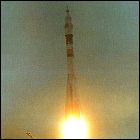 The Soviet Union launches Soyuz 32 on a long-duration mission to space station Salyut 6, with cosmonauts Vladimir Lyakhov and Valery Ryumin aboard. Over a record-setting 175 days, the new station crew conducts necessary repairs and upgrades to the station’s hardware, as well as conducting various experiments. With the arrival of equipment sent in the unmanned Progress 5 freighter in March, this is the first space crew to have a means to see ground controllers via a video link, rather than talking to them via radio; the cosmonauts also look forward to seeing family members during planned teleconferences. This is also the first crew to vacation in space, permitted a five-day break over May Day. Due to a major technical problem in the next manned Soyuz flight, the crew of Salyut 7 sets its duration record without a single visit from another cosmonaut.
The Soviet Union launches Soyuz 32 on a long-duration mission to space station Salyut 6, with cosmonauts Vladimir Lyakhov and Valery Ryumin aboard. Over a record-setting 175 days, the new station crew conducts necessary repairs and upgrades to the station’s hardware, as well as conducting various experiments. With the arrival of equipment sent in the unmanned Progress 5 freighter in March, this is the first space crew to have a means to see ground controllers via a video link, rather than talking to them via radio; the cosmonauts also look forward to seeing family members during planned teleconferences. This is also the first crew to vacation in space, permitted a five-day break over May Day. Due to a major technical problem in the next manned Soyuz flight, the crew of Salyut 7 sets its duration record without a single visit from another cosmonaut.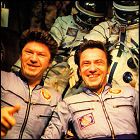 The Soviet Union launches Soyuz 35 en route to space station Salyut 6 for a long-duration stay. Cosmonauts Leonid Popov and Valery Ryumin set a new space endurance record with their 185-day stay, lasting until October 1980. Ryumin had been a member of the last Salyut 6 crew as well, having stayed on the station for six months in 1979, and was not originally scheduled for this mission, rotated into the prime crew due to the illness of the originally assigned crew member. Four other crews visit Salyut 6 during the Soyuz 35 crew’s stay. By the end of this mission, Ryumin holds a personal record for the most time accrued in space by a human being – 352 days, barely two weeks short of a full year of spaceflight experience.
The Soviet Union launches Soyuz 35 en route to space station Salyut 6 for a long-duration stay. Cosmonauts Leonid Popov and Valery Ryumin set a new space endurance record with their 185-day stay, lasting until October 1980. Ryumin had been a member of the last Salyut 6 crew as well, having stayed on the station for six months in 1979, and was not originally scheduled for this mission, rotated into the prime crew due to the illness of the originally assigned crew member. Four other crews visit Salyut 6 during the Soyuz 35 crew’s stay. By the end of this mission, Ryumin holds a personal record for the most time accrued in space by a human being – 352 days, barely two weeks short of a full year of spaceflight experience.